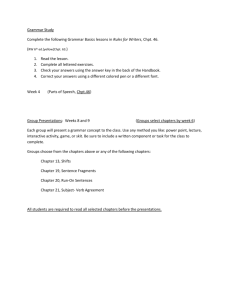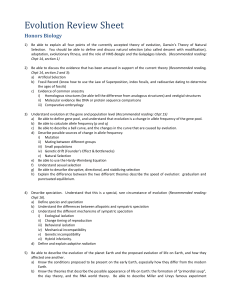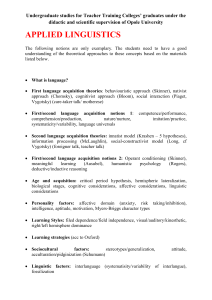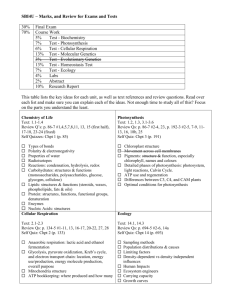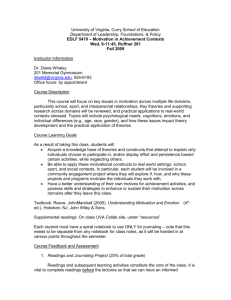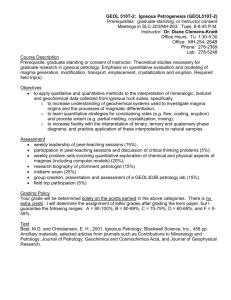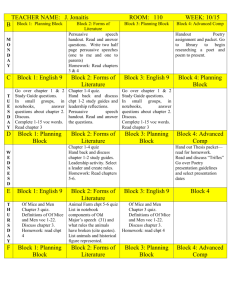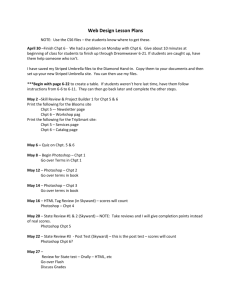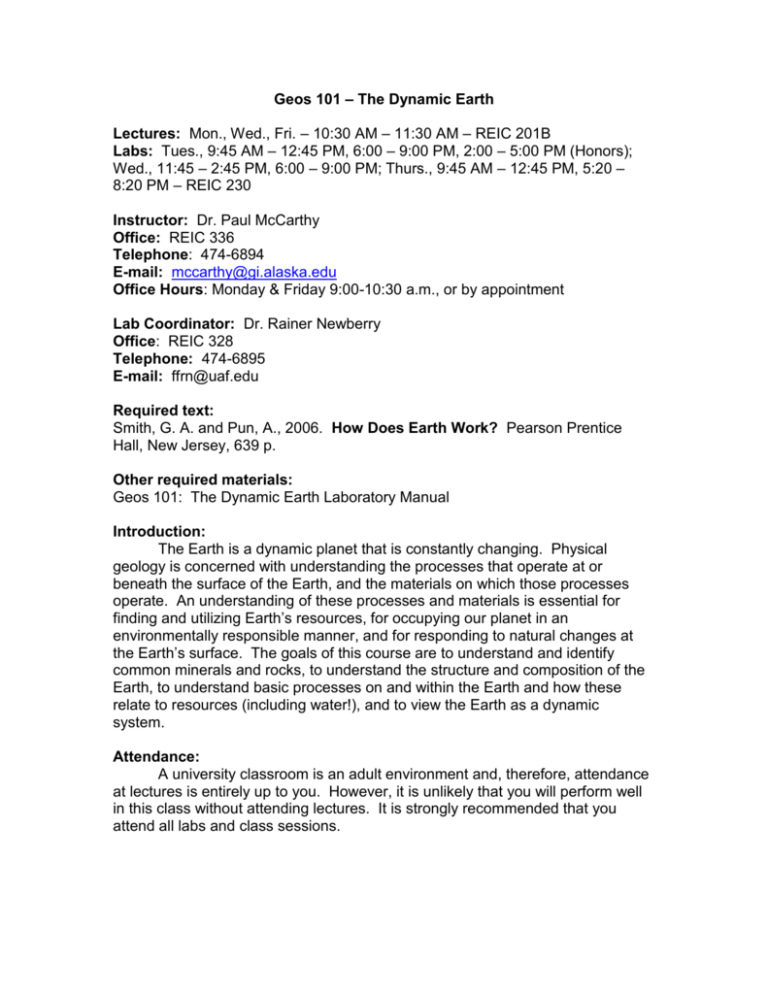
Geos 101 – The Dynamic Earth
Lectures: Mon., Wed., Fri. – 10:30 AM – 11:30 AM – REIC 201B
Labs: Tues., 9:45 AM – 12:45 PM, 6:00 – 9:00 PM, 2:00 – 5:00 PM (Honors);
Wed., 11:45 – 2:45 PM, 6:00 – 9:00 PM; Thurs., 9:45 AM – 12:45 PM, 5:20 –
8:20 PM – REIC 230
Instructor: Dr. Paul McCarthy
Office: REIC 336
Telephone: 474-6894
E-mail: mccarthy@gi.alaska.edu
Office Hours: Monday & Friday 9:00-10:30 a.m., or by appointment
Lab Coordinator: Dr. Rainer Newberry
Office: REIC 328
Telephone: 474-6895
E-mail: ffrn@uaf.edu
Required text:
Smith, G. A. and Pun, A., 2006. How Does Earth Work? Pearson Prentice
Hall, New Jersey, 639 p.
Other required materials:
Geos 101: The Dynamic Earth Laboratory Manual
Introduction:
The Earth is a dynamic planet that is constantly changing. Physical
geology is concerned with understanding the processes that operate at or
beneath the surface of the Earth, and the materials on which those processes
operate. An understanding of these processes and materials is essential for
finding and utilizing Earth’s resources, for occupying our planet in an
environmentally responsible manner, and for responding to natural changes at
the Earth’s surface. The goals of this course are to understand and identify
common minerals and rocks, to understand the structure and composition of the
Earth, to understand basic processes on and within the Earth and how these
relate to resources (including water!), and to view the Earth as a dynamic
system.
Attendance:
A university classroom is an adult environment and, therefore, attendance
at lectures is entirely up to you. However, it is unlikely that you will perform well
in this class without attending lectures. It is strongly recommended that you
attend all labs and class sessions.
Grades:
Your final grade for this course will be determined as follows:
Mid-term examination #1 – 15%
Mid-term examination #2 – 15%
Laboratory exercises – 40%
Final examination – 30%
The two mid-term examinations will encompass the first and second thirds of
the course respectively. The final examination will be cumulative, encompassing
material from the entire semester, although the emphasis will rest heavily on the
final third.
The final examination will be given only on the day and time scheduled by
the university.
Labs:
A fundamental goal of this class is to give you the tools to interpret the
geologic features that you encounter on a daily basis. Reading topographic
maps, interpreting aerial photos, and identifying rocks and minerals are practical
skills that will be of use to you whether you decide to become a geologist or not.
It is in the lab that you will have the opportunity to apply your geological
knowledge and practice these new skills.
A pre-lab is found at the start of each lab exercise in your lab manual.
Your lab manual will be handed out to you at the start of your first lab. The prelab is designed to introduce some basic concepts and to get you thinking about
the material that will be covered in the next week’s lab. Pre-labs are to be
handed in at the beginning of your lab period. Labs are to be handed in to your
TA in your lab session.
Completion of lab assignments is essential for understanding course
material. The labs are designed so that you can complete them within the three
hour lab period. However, labs will require that you commit yourself for most, or
all, of the 3 hours. Do not schedule other activities during any portion of the lab
period. If you have a conflict, you can make it up by attending another lab
section. Please notify your TA the week before if this will be necessary.
You will be allowed to drop one lab mark from your final grade if, and only
if, you have completed all of the laboratory assignments for the semester.
Field Trips:
The second and fourth labs of the semester contain a local field trip
component. These trips will give you a chance to examine rocks and minerals in
their natural environment and will provide you with an appreciation for the types
of rocks and geologic structures in and around Fairbanks. Be sure to wear
appropriate clothing – e.g. sturdy shoes or boots, a warm jacket and raincoat
(just in case!). The field trips will “go” regardless of weather. Attendance on the
field trips is mandatory and a “missed” field trip lab cannot be made up in later
weeks.
Questions:
There is no such thing as a foolish question. If you don’t understand what
I’m saying, please stop me and ask for clarification. Chances are someone else
in class isn’t understanding either! If you’re not comfortable asking questions in
class, please ask after the lecture or send an e-mail or drop by my office so we
can clear up any confusion. That’s what I’m here for!
Tentative Lecture Schedule
Date
September 7 (F)
September 10 (M)
September 12 (W)
September 14 (F)
Week of Sept. 10-14
September 17 (M)
September 19 (W)
September 21 (F)
Week of Sept. 17-21
September 24 (M)
September 26 (W)
September 28 (F)
Week of Sept. 24-28
October 1 (M)
October 3 (W)
October 5 (F)
Week of Oct. 1-5
October 8 (M)
October 10 (W)
October 12 (F)
Week of Oct. 8-12
October 15 (M)
October 17 (W)
October 19 (F)
Lecture/Lab Topic
Mineralogy: identification
Mineralogy: the basics
Mineralogy: structures
From sediment to
sedimentary rocks
Lab #1 – Mineral properties
and identification
Sedimentary Environments
Weathering
Geologic time and relative
sequence of events
Lab #2 – Sedimentary
rocks and processes
Radiometric dating and
absolute ages
Soils and Paleosols
Folds and ductile
deformation
Lab #3 – Mineral
compositions, colors, ages
Faults, fractures and brittle
deformation
Mid-term Exam #1
Igneous rocks
Lab #4 – The 3 major rock
types – Field trip
Magma and intrusive
igneous rocks
Volcanoes, lava and
extrusive igneous rocks
Metamorphic Rocks
Lab #5 – Igneous rocks and
processes
Metamorphic Processes
Metamorphic Processes
Topographic Maps
Reading
Chpt. 2 – p. 24-29
Chpt. 2 – p. 29-36
Chpt. 2 – p. 36-44
Chpt. 5 – p. 111-120
Chpt. 5 – p. 120-131
Chpt. 5 – p. 102-111
Chpt. 7 – p. 166-179
Chpt. 7 – p. 180-195
Chpt. 14
Chpt. 11 – p. 270-274; 280290
Chpt. 11- p. 274-279
Chpt. 4 – p. 66-73
Chpt. 4 – p. 82-93
Chpt. 4 – p. 73-82; 93-100
Chpt. 6 – p. 152-157
Chpt. 6 – p. 134-152
Chpt. 6 – p. 158-165
Week of Oct. 15-19
October 22 (M)
October 24 (W)
October 26 (F)
Week of Oct. 22-26
October 29 (M)
October 31 (W)
November 2 (F)
Week of Oct. 29-Nov. 2
November 5 (M)
November 7 (W)
November 9 (F)
Week of Nov. 5-9
November 12 (M)
November 14 (W)
November 16 (F)
Week of Nov. 12-16
November 19 (M)
November 21 (W)
November 23 (F)
Week of Nov. 19-23
November 26 (M)
November 28 (W)
November 30 (F)
Week of Nov. 26-30
December 3 (M)
December 5 (W)
December 7 (F)
Week of Dec. 3-7
December 10 (M)
Lab #6 – Metamorphic
rocks and processes
Making Earth
Making Earth
Geologic maps and
structures
Lab #7 – Understanding
topographic maps
Energy Resources in Alaska
Earthquakes
Mid-term Exam #2
Lab #8 – Geologic maps
and geologic structures
Seismology and structure of
Earth’s interior
Earth’s magnetic field
Paleomagnetism and
continental drift
Lab #9 – Earthquakes and
seismic waves
Tectonics: plates and plate
boundaries
Tectonics: crustal
dynamics
Mass wasting
Lab #10 – Earth magnetism
and faults in Alaska
Wind and deserts
Oceans and ocean processes
Thanksgiving – no classes
Thanksgiving – no labs
Rivers and deltas I
Rivers and deltas II
Groundwater:
fundamentals
Lab #11 – Air photos and
remote sensing
Groundwater: chemistry
and karst
Glaciers
Glaciers: erosion and
deposition
Lab #12 – Groundwater
hydrology
Ice ages and permafrost
Chpt. 9
Chpt. 9
Chpt. 11 – p. 275
Chpt. 11 – p. 291-305
Chpt. 8
Chpt. 10
Chpt. 12 – p. 308-310
Chpt. 12 – p. 311-341
Chpt. 12 – p. 342-348;
Chpt. 13
Chpt. 15
Chpt. 20
Chpt. 19
Chpt. 16
Chpt. 16
Chpt. 17 – p. 482-504
Chpt. 17 – p. 482-504
Chpt. 18 – p. 516-528
Chpt. 18 – p. 528-548
Chpt. 18 – p. 548-563
December 12 (W)
December 14 (F)
Week of Dec. 10-14
December 19 (W)
Global Change
Global Change – a
geological perspective
Lab #13 – Glacial geology
Final Exam – REIC 201B
10:15 a.m.- 12:15 p.m.

